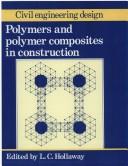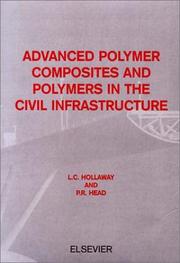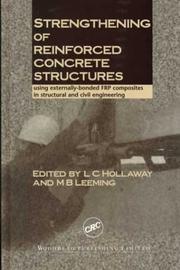| Listing 1 - 10 of 15 | << page >> |
Sort by
|

ISBN: 0727715216 Year: 1990 Publisher: London Telford
Abstract | Keywords | Export | Availability | Bookmark
 Loading...
Loading...Choose an application
- Reference Manager
- EndNote
- RefWorks (Direct export to RefWorks)
#KVIV:BB --- Bouwconstructies --- Bouwkundige toepassingen --- Bouwmaterialen --- Plastics --- Polyesters --- Rubber --- Vezelversterkte bouwmaterialen --- Bouwconstructies. --- Bouwkundige toepassingen. --- Bouwmaterialen. --- Plastics. --- Polyesters. --- Rubber. --- Vezelversterkte bouwmaterialen.
Book
Year: 1978 Publisher: Glasgow : Surrey university press,
Abstract | Keywords | Export | Availability | Bookmark
 Loading...
Loading...Choose an application
- Reference Manager
- EndNote
- RefWorks (Direct export to RefWorks)
Digital
ISBN: 9781845698607 1845698606 Year: 1994 Publisher: Cambridge Woodhead Publishing Ltd
Abstract | Keywords | Export | Availability | Bookmark
 Loading...
Loading...Choose an application
- Reference Manager
- EndNote
- RefWorks (Direct export to RefWorks)
This book introduces the engineer to fibres and polymer matrices, which are the components of the polymer composites for structural engineering. The authors also provide a simple guide, in tabular form, to the principal fabrication techniques, the basic design formulae, and the methods for structural composites systems and connections.
Book
Year: 1995 Publisher: Oxford Butterworth-Heinemann
Abstract | Keywords | Export | Availability | Bookmark
 Loading...
Loading...Choose an application
- Reference Manager
- EndNote
- RefWorks (Direct export to RefWorks)
Book
Year: 1978 Publisher: Glasgow : Surrey University Press,
Abstract | Keywords | Export | Availability | Bookmark
 Loading...
Loading...Choose an application
- Reference Manager
- EndNote
- RefWorks (Direct export to RefWorks)
Glass-reinforced plastics --- Plastics in building --- Glass-reinforced plastics --- Plastics in building

ISBN: 1281036749 9786611036744 0080526438 0080436617 0444634193 9780080436616 9780080526430 9781281036742 Year: 2001 Publisher: Amsterdam ; New York : Elsevier,
Abstract | Keywords | Export | Availability | Bookmark
 Loading...
Loading...Choose an application
- Reference Manager
- EndNote
- RefWorks (Direct export to RefWorks)
Advanced Polymer Composites and Polymers in the Civil Infrastructure
Polymeric composites. --- Reinforced plastics. --- Composite materials --- Plastics --- Polyesters --- Composite polymeric materials --- Polymer-matrix composites --- Reinforced plastics

ISBN: 1591246059 9781591246053 1855737612 9781855737617 0849317150 9780849317156 9781855733787 Year: 1999 Publisher: Cambridge, England Woodhead Pub
Abstract | Keywords | Export | Availability | Bookmark
 Loading...
Loading...Choose an application
- Reference Manager
- EndNote
- RefWorks (Direct export to RefWorks)
This book presents a detailed study of the flexural strengthening of reinforced and prestressed concrete members using fibre reinforced polymer composite plates. The authors also discuss plate bonding onto other engineering materials such as steel and cast iron. The book has been designed for practising civil and structural engineers seeking to understand the principles and design technology of plate bonding, and for final year undergraduates and postgraduate engineers studying the principles of highway and bridge engineering and structural engineering.

ISBN: 9780080436616 0080436617 9780080526430 0080526438 1281036749 9781281036742 Year: 2001 Publisher: New York Elsevier Science
Abstract | Keywords | Export | Availability | Bookmark
 Loading...
Loading...Choose an application
- Reference Manager
- EndNote
- RefWorks (Direct export to RefWorks)
In recent years, the fabrication technologies for the production of advanced polymer composites have been revolutionised by sophisticated manufacturing techniques. These methods have enabled polymer composite materials to produce good quality laminates with minimal voids and accurate fibre alignment. This book familiarises and provides a background to the understanding and use of advanced polymer composites in the civil infrastructure; numerous examples have been provided to illustrate the use and versatility of the material. Furthermore, the book discusses the current fabrication techniques, design methods and formulae for the design of structural composite systems. In addition it discusses the fundamentals of geosynthetics used in geotechnical engineering. The book introduces the fibres and matrices that are used to manufacture composites, their mechanical and in-service properties and their long term loading characteristics; all these properties are specifically associated with the construction industry. The chapters then discuss the design aspects for 'all composite' units, as well as systems used for the renewal of civil infrastructure. Finally, the book demonstrated the unique possibilities of combining composites with conventional materials to form units in which the various materials making up the unit are loaded in the mode that specifically suits their mechanical characteristics.
Digital
ISBN: 9781439832448 1439832447 9781845694890 1845694899 Year: 2008 Publisher: Boca Raton, FL CRC Press
Abstract | Keywords | Export | Availability | Bookmark
 Loading...
Loading...Choose an application
- Reference Manager
- EndNote
- RefWorks (Direct export to RefWorks)
The repair of deteriorated, damaged and substandard civil infrastructures has become one of the most important issues for the civil engineer worldwide. This important book discusses the use of externally-bonded fibre-reinforced polymer (FRP) composites to strengthen, rehabilitate and retrofit civil engineering structures, covering such aspects as material behaviour, structural design and quality assurance. The first three chapters of the book review structurally-deficient civil engineering infrastructure, including concrete, metallic, masonry and timber structures. FRP composites used in rehabilitation and surface preparation of the component materials are also reviewed. The next four chapters deal with the design of FRP systems for the flexural and shear strengthening of reinforced concrete (RC) beams and the strengthening of RC columns. The following two chapters examine the strengthening of metallic and masonry structures with FRP composites. The last four chapters of the book are devoted to practical considerations in the flexural strengthening of beams with unstressed and prestressed FRP plates, durability of externally bonded FRP composite systems, quality assurance and control, maintenance, repair, and case studies. With its distinguished editors and international team of contributors, Strengthening and rehabilitation of civil infrastructures using fibre-reinforced polymer (FRP) composites is a valuable reference guide for engineers, scientists and technical personnel in civil and structural engineering working on the rehabilitation and strengthening of the civil infrastructure. Reviews the use of fibre-reinforced polymer (FRP) composites in structurally damaged and sub-standard civil engineering structuresExamines the role and benefits of fibre-reinforced polymer (FRP) composites in different types of structures such as masonry and metallic strengtheningCovers practical considerations including material behaviour, structural design and quality assurance.
Book
ISBN: 1845694899 1845694481 9781439832448 1439832447 9781845694890 9781420087741 1420087746 9781845694487 Year: 2008 Publisher: Burlington : Elsevier Science,
Abstract | Keywords | Export | Availability | Bookmark
 Loading...
Loading...Choose an application
- Reference Manager
- EndNote
- RefWorks (Direct export to RefWorks)
The repair of deteriorated, damaged and substandard civil infrastructures has become one of the most important issues for the civil engineer worldwide. This important book discusses the use of externally-bonded fibre-reinforced polymer (FRP) composites to strengthen, rehabilitate and retrofit civil engineering structures, covering such aspects as material behaviour, structural design and quality assurance.The first three chapters of the book review structurally-deficient civil engineering infrastructure, including concrete, metallic, masonry and timber structures. FRP composites used i
Polymeric composites. --- Composite polymeric materials --- Polymer-matrix composites --- Reinforced plastics
| Listing 1 - 10 of 15 | << page >> |
Sort by
|

 Search
Search Feedback
Feedback About UniCat
About UniCat  Help
Help News
News